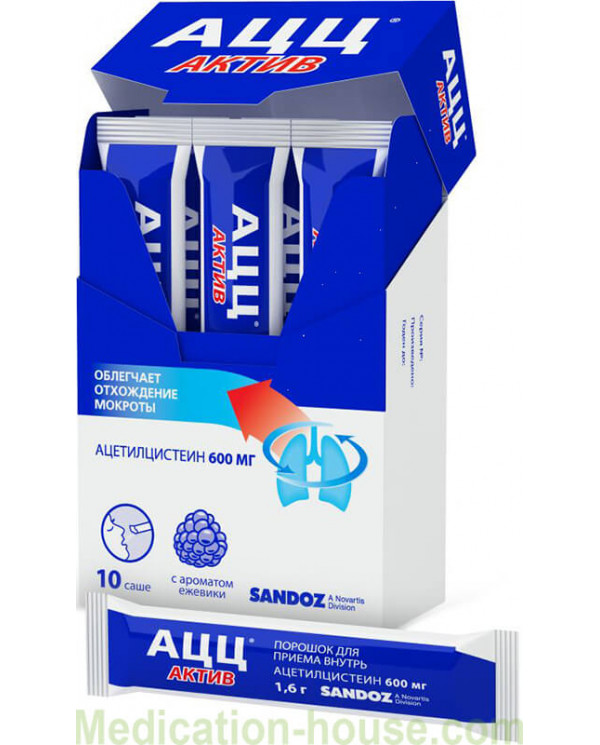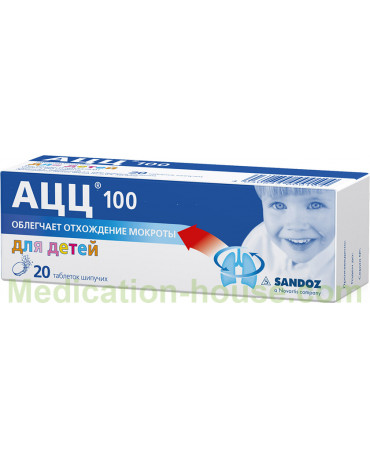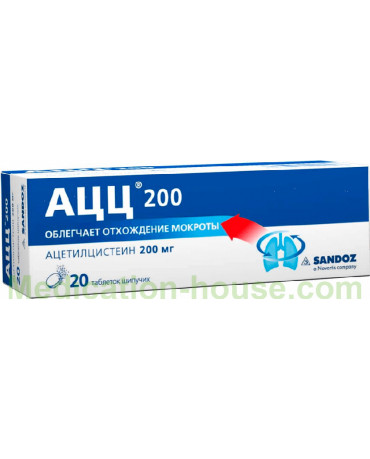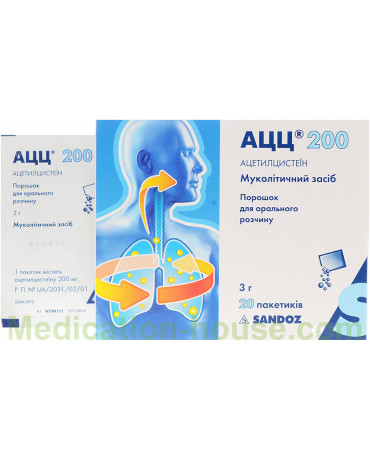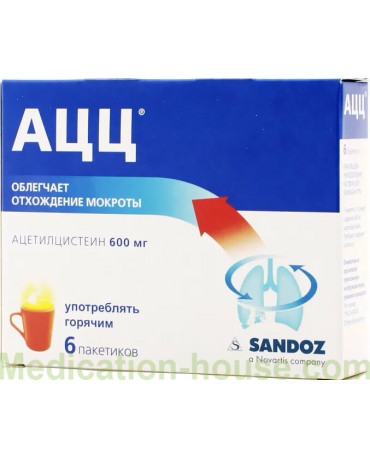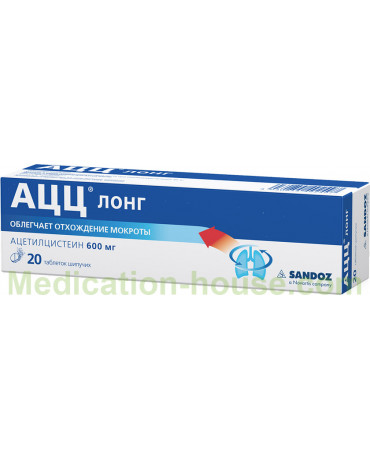ACC Active instruction
You can buy ACC Active here
Sachet ACC Active is convenient to take with you!
Only 1 time per day.
A unique form1 for buyers who lead an active lifestyle who have no time to get sick.
The outer coating provides easy swallowing without water and a pleasant taste.
The direct-action formula helps dissolve sputum and remove it from the lungs.
Effect from 1 day of application.
Composition
1 sachet contains:
active substance: acetylcysteine 600 mg; excipients: glyceryl tripalmitate, polysorbate 65, sorbitol, xylitol, citric acid, sodium citrate, magnesium citrate, carmellose sodium, aspartame, Blackberry B flavoring (natural / identical to natural Forest Berry flavoring, code 5752; natural / identical to natural Blackberry liquid flavoring, code 5337; vanillin; maltodextrin; mannitol; gluconolactone; sorbitol; colloidal silicon dioxide anhydrous; magnesium carbonate), magnesium stearate.
Pharmacodynamics
Acetylcysteine is a derivative of the amino acid cysteine. It has a mucolytic and secretory effect in the respiratory tract, facilitates sputum discharge due to a direct effect on the rheological properties of sputum. The action of ACC Active is due to the ability of its free sulfhydryl groups to break the intra- and intermolecular disulfide bonds of acid mucopolysaccharides of sputum, which leads to the depolymerization of mucoproteins and a decrease in the viscosity of sputum.
In addition, it reduces induced hyperplasia of mucoid cells, enhances the production of surface-active compounds (surfactant) by stimulating type II pneumocytes, and stimulates ciliary activity, which leads to an improvement in mucociliary clearance.
ACC Active remains active in the presence of purulent, mucopurulent and mucous sputum.
Increases the secretion of less viscous sialomucins by goblet cells, reduces the adhesion of bacteria on the epithelial cells of the bronchial mucosa. Stimulates the cells of the mucous membrane of the bronchi, the secret of which lyses fibrin.
It has a similar effect on the secret formed in inflammatory diseases of the ENT organs.
It has an antioxidant effect due to the presence of sulfhydryl groups (SH-groups) that can neutralize electrophilic oxidative toxins. Acetylcysteine easily penetrates into the cell, where it is deacetylated to L-cysteine, from which intracellular glutathione is synthesized. Glutathione is a highly reactive tripeptide, a powerful antioxidant, a cytoprotector that traps endogenous and exogenous free radicals and toxins. Acetylcysteine prevents depletion and helps to increase the synthesis of intracellular glutathione, which is involved in redox processes in cells, thereby contributing to the detoxification of harmful substances. This explains the effect of acetylcysteine as an antidote for paracetamol poisoning. Paracetamol exerts its cytotoxic effect through the progressive depletion of glutathione. The main role of acetylcysteine is to maintain an appropriate level of glutathione concentration, which provides protection for cells.
Protects alpha-1-antitrypsin (an elastase inhibitor) from the inactivating effect of HOCl, an oxidizing agent produced by myeloperoxidase of active phagocytes. It also has an anti-inflammatory effect (due to the suppression of the formation of free radicals and active oxygen-containing substances responsible for the development of inflammation in the lung tissue).
With the prophylactic use of acetylcysteine, a decrease in the frequency and severity of exacerbations of bacterial infections in patients with chronic bronchitis and cystic fibrosis is noted.
Pharmacokinetics
Suction
Acetylcysteine is rapidly and almost completely absorbed by ingestion. Due to the high presystemic metabolism (the effect of the "primary passage" through the liver), the bioavailability of oral forms of acetylcysteine is about 10%. The maximum concentration (Cmax) of acetylcysteine in blood plasma after oral administration is achieved after 1-3 hours and is 15 mmol / L, Cmax of the cysteine metabolite is approximately 2 μmol / L.
Distribution
Communication with blood plasma proteins is about 50% after 4 hours and decreases to 20% after 12 hours.
Acetylcysteine is distributed both unchanged (20%) and as active metabolites (80%), penetrates the intercellular space, distributed mainly in the liver, kidneys, lungs and bronchial secretions. Acetylcysteine crosses the placental barrier and is detected in cord blood. There is no information on excretion in breast milk. There is no evidence of the ability of acetylcysteine to cross the blood-brain barrier.
Metabolism
Acetylcysteine is metabolized in the liver to cysteine, a pharmacologically active metabolite, as well as to diacetylcysteine, cystine, and other mixed disulfides. In the body, acetylcysteine and its metabolites can be detected in different forms: in free form, associated with plasma proteins by labile disulfide bonds, or as combined amino acids.
Breeding
Acetylcysteine is excreted almost exclusively in the form of inactive metabolites (inorganic sulfates, diacetylcysteine) by the kidneys, a small part is excreted unchanged through the intestines. The half-life of ACC Active from blood plasma (T1 / 2) is approximately 1 hour and depends on the rate of biotransformation in the liver. In case of impaired liver function, T1 / 2 acetylcysteine can increase up to 8 hours.
Side effects
According to the World Health Organization (WHO), adverse reactions are classified according to their frequency of development as follows: very often (> 1/10), often (from> 1/100 to <1/10), infrequently (from> 1/1000 to <1/100), rarely (from> 1/10000 to <1/1000), very rarely (<1/10000); the frequency is unknown - according to the available data, it was not possible to establish the frequency of occurrence.
Disorders from the immune system infrequently: hypersensitivity reactions;
very rarely: anaphylactic shock, anaphylactic / anaphylactoid reactions.
Disturbances from the nervous system infrequently: headache.
Violations of the heart and blood vessels infrequently, tachycardia, arterial hypotension; very rare, bleeding *;
frequency is unknown: when taking acetylcysteine, cases of the development of collapse are described.
Respiratory system disorders
seldom: shortness of breath, bronchospasm (mainly in patients with bronchial hyperreactivity on the background of bronchial asthma).
Disorders from the gastrointestinal tract infrequently: abdominal pain, nausea, vomiting, diarrhea, stomatitis; rarely: dyspepsia; frequency unknown: heartburn.
Disorders of the skin and subcutaneous tissue
infrequently, urticaria, exanthema, rash, angioedema, pruritus; very rarely: Stevens-Johnson syndrome, Lyell syndrome (see section "Special instructions").
Hearing disorders and labyrinth disorders infrequently: tinnitus.
Common disorders infrequently: fever; frequency unknown: swelling of the face.
* Single reports of the development of bleeding with the use of acetylcysteine, sometimes together with hypersensitivity reactions. A decrease in platelet aggregation with the use of acetylcysteine has been confirmed in some studies, the clinical significance of this phenomenon has not yet been elucidated.
Special conditions
In patients with bronchial asthma and obstructive bronchitis, acetylcysteine should be prescribed with caution under systemic control of bronchial obstruction. If the patient is not able to cough up effectively, it is necessary to drain or aspirate the secretion.
With the use of acetylcysteine, cases of the development of severe allergic reactions, such as Stevens-Johnson syndrome and Lyell's syndrome, have been very rarely reported. If changes in the skin and mucous membranes occur, you should immediately consult a doctor, you must stop taking ACC Active.
You should not take ACC Active immediately before bedtime (it is recommended to take the drug before 18.00).
Influence on laboratory data. Acetylcysteine can affect the results of colorimetric determination of the concentration of salicylates in blood plasma. In urinalysis, acetylcysteine can affect the results of determination of ketone bodies.
Indications
Acute and chronic respiratory diseases associated with the formation of a viscous, difficult to separate bronchial secretion (as an expectorant): bronchitis, tracheitis, bronchiolitis, pneumonia, bronchiectatic disease, cystic fibrosis, lung abscess, pulmonary emphysema, laryngotracheitis, interstitial lung disease, atelecta obstruction of the bronchi with a mucous plug).
Inflammation of the middle ear (otitis media), acute and chronic sinusitis, rhinosinusitis (relieving secretion).
Removing viscous secretions from the respiratory tract in post-traumatic and postoperative conditions.
Contraindications
Hypersensitivity to acetylcysteine or other components of ACC Active;
hemoptysis, pulmonary hemorrhage;
peptic ulcer of the stomach and duodenum in the acute stage;
children's age up to 18 years (for this dosage form);
pregnancy and the period of breastfeeding;
hereditary fructose intolerance (contains sorbitol), phenylketonuria (contains a source of phenylalanine aspartame).
Drug interaction
With the simultaneous use of acetylcysteine with antitussive drugs due to the suppression of the cough reflex, stagnation of sputum in the bronchi may occur. Before prescribing such combination therapy, a thorough assessment of the patient's condition is necessary.
Current reports of acetylcysteine inactivation of antibacterial drugs such as tetracyclines (with the exception of doxycycline), aminoglycosides, cephalosporins, penicillins (ampicillin), as well as antifungals (amphotericin B) refer exclusively to in vitro studies (pharmaceutical incompatibility). Nevertheless, antibacterial drugs for oral administration and ACC Active should be used with an interval of at least 2 hours (not applicable to cefixime and loracarbef).
Concomitant use with acetylcysteine can lead to increased vasodilating and antiplatelet effects of nitroglycerin. If combined use of nitroglycerin and acetylcysteine is required, then the patient should be monitored for potential development of arterial hypotension (sometimes severe, headache may occur).
The simultaneous use of acetylcysteine and carbamazepine can be expressed in a decrease in the concentration of carbamazepine to a subtherapeutic level.
The simultaneous use of activated carbon can reduce the effect of acetylcysteine.
Acetylcysteine eliminates the toxic effects of paracetamol.
Dosage
Inside. Powder from 1 sachet should be poured directly onto the tongue. ACC Active stimulates salivation, so the powder is mixed with saliva and is easily swallowed. The drug does not require drinking water. Powder for oral administration should not be chewed before swallowing.
Adults: 1 sachet once a day (equivalent to 600 mg of acetylcysteine per day).
Due to the high acetylcysteine content (600 mg) in 1 sachet, ACC Active should not be used in children (it is recommended to use other dosage forms of ACC or another acetylcysteine drug). The duration of treatment should be evaluated individually. With short-term colds, the duration of the course is 5-7 days, in the treatment of chronic diseases - up to several months (on the recommendation of a doctor).
Overdose
Cases of toxic overdose when taking acetylcysteine inside are not described. Acetylcysteine when taken in doses up to 500 mg / kg / day did not cause overdose symptoms. Healthy volunteers received acetylcysteine at a dose of 11.6 g per day for 3 months without the development of any serious adverse reactions.
Symptoms: gastrointestinal manifestations such as nausea, vomiting, and diarrhea may occur.
Treatment: symptomatic therapy if necessary.
Terms of sell
You don't need a prescription to buy ACC Active.

